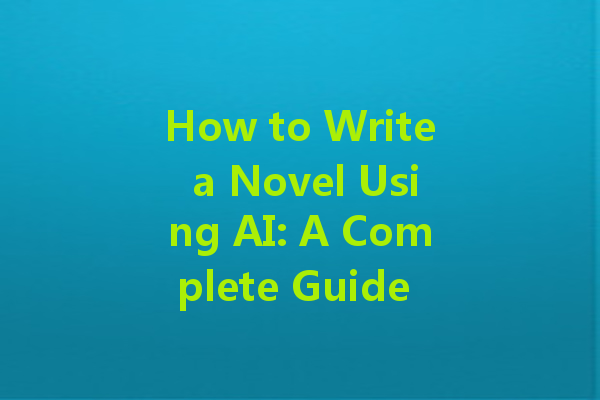共计 3296 个字符,预计需要花费 9 分钟才能阅读完成。

Writing a novel can often feel like a daunting task, and many aspiring authors grapple with various challenges along the way. Fortunately, advancements in artificial intelligence (AI) have made it easier than ever to develop ideas, structure stories, and even generate text. In this guide, we’ll explore how to effectively use AI writing models and instructions to aid you in your novel-writing journey.
参考文章: 人工智能:现状与未来
Understanding AI Writing Models
AI writing models utilize sophisticated algorithms to create text that mimics human writing. These models are trained on vast amounts of data, allowing them to generate compelling narratives, characters, and dialogue. Some popular AI writing tools include OpenAI’s ChatGPT, Jasper, and Writesonic.
When choosing an AI writing model for your novel, consider factors such as ease of use, the quality of output, and available features. Some tools even offer a free version, allowing you to experiment without any financial commitment. 
Generating Ideas and Outlining Your Novel
Before diving into the actual writing, it’s essential to brainstorm ideas and create an outline. Here’s how AI can assist in this process:
You can use AI to generate prompts based on specific themes or genres you’re interested in. For example, you might ask the AI for “mystery story ideas set in a small town.” This can spark your creativity and lead to more developed concepts for your novel.
参考文章: 探索最佳 AI 写作工具,助你提升创作效率和收益,解析从免费软件到论文生成的全面指南
Once you have a basic idea, use AI to help structure your plot. AI can suggest typical narrative arcs – such as the three-act structure or the hero’s journey. This guidance can help you organize your thoughts and ensure your story has a compelling flow.
Writing Your Novel
With a solid outline in place, it’s time to start writing. Here’s how to make the most of AI during the writing phase:
You can utilize AI writing models to assist in drafting chapters or sections of your novel. Simply provide a brief summary of what you want to happen in a particular scene, and let the AI generate a draft. Remember, the output will likely need refinement, but this serves as a great starting point.
AI can also help you develop your characters. By describing their traits, motivations, and relationships, you can ask the AI to generate character backstories or even dialogues. This can enrich your character development and make your story more engaging.
Writing realistic dialogue can be challenging, but AI can assist in generating conversations between characters. You can prompt the AI by providing context or character descriptions and asking it to draft a dialogue exchange that feels authentic.
Editing and Refining
Once you have a complete draft, it’s vital to revise and refine your work. AI tools can assist by:
Some AI writing models come with editing features. They can analyze your writing for grammar, style, and coherence, providing suggestions for improvement. Utilizing these insights can enhance the overall quality of your manuscript.
When you need to tighten up your prose or rephrase sentences for clarity or impact, AI can offer alternative phrasings. Just ensure that you review AI-generated suggestions to maintain your unique voice.
Final Thoughts
Using AI to write a novel can significantly streamline your writing process and enhance your creativity. However, it’s important to remember that AI is a tool, not a replacement for your creative instincts. The best results come when you integrate AI-generated content with your own ideas and style.
With the right approach, you can leverage AI writing models and instructions to craft a compelling and engaging story. So why not give it a try? Embrace the future of writing and start your novel today!
—







